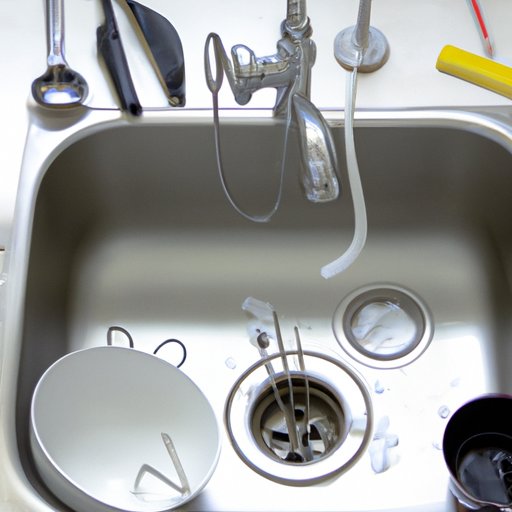Introduction
A clogged kitchen sink can be a major inconvenience. Water will not flow properly, leaving dishes unwashed and the sink unused. Fortunately, there are several ways to unclog a kitchen sink and restore it to its normal function. In this article, we will explore the different methods to unclog a kitchen sink and discuss the pros and cons of each approach.
Boiling Water Method
The simplest and most common way to unclog a kitchen sink is to pour boiling water down the drain. Boiling water is effective in breaking up grease, soap scum, and other debris that can cause a blockage.
Step-by-Step Instructions
To use the boiling water method, follow these steps:
- Boil a pot of water.
- Carefully pour the boiling water down the drain.
- Allow the boiling water to sit for 5 minutes.
- Run cold water through the drain for 1 minute.
Pros and Cons
The boiling water method is simple, inexpensive, and effective in most cases. However, boiling water can be dangerous if handled improperly, so caution should be used when pouring the hot water down the drain. Additionally, boiling water is not effective at removing solid objects from the drain.
Baking Soda and Vinegar Method
Baking soda and vinegar are two common household items that can be used to unclog a kitchen sink. The combination of baking soda and vinegar creates a chemical reaction that breaks up debris and helps remove it from the drain.
Step-by-Step Instructions
To use the baking soda and vinegar method, follow these steps:
- Pour ½ cup of baking soda down the drain.
- Pour 1 cup of white vinegar down the drain.
- Cover the drain and let the mixture sit for 30 minutes.
- Flush the drain with hot water.
Pros and Cons
Using baking soda and vinegar is an effective and natural way to unclog a kitchen sink. It is also relatively safe, as both ingredients are non-toxic. The only downside is that this method can take longer than other methods, since it requires waiting for the mixture to sit for 30 minutes.
Plunger Method
A plunger is a tool that uses suction to break up and remove blockages from drains. Plungers are effective at removing solid objects such as food particles and hair from the drain.
Step-by-Step Instructions
To use the plunger method, follow these steps:
- Fill the sink with enough water to cover the plunger.
- Place the plunger over the drain and press firmly.
- Move the plunger up and down quickly 10-15 times.
- Remove the plunger and flush the drain with hot water.
Pros and Cons
The plunger method is fast, easy, and effective. The only downside is that it can be messy, as water and debris may splatter out of the drain when the plunger is being used.
Wire Hanger Method
A wire hanger can be used to reach into the drain and remove debris that is causing the blockage. This method is effective at removing solid objects such as food particles and hair.
Step-by-Step Instructions
To use the wire hanger method, follow these steps:
- Unbend a wire hanger and straighten it out.
- Use the hook at the end of the hanger to reach into the drain and remove any visible debris.
- Flush the drain with hot water.
Pros and Cons
The wire hanger method is fast, easy, and effective. However, it can be difficult to reach deep into the drain with the hanger, and it is possible to scratch or damage the pipe if not done carefully.
Commercial Drain Cleaner Method
Commercial drain cleaners are chemical compounds designed to break up and dissolve blockages in drains. These products are generally effective, but they can be harsh and potentially damaging to pipes if used incorrectly.
Step-by-Step Instructions
To use the commercial drain cleaner method, follow these steps:
- Read and follow the instructions on the package carefully.
- Pour the cleaner down the drain.
- Allow the cleaner to sit for the amount of time indicated on the package.
- Flush the drain with hot water.
Pros and Cons
Commercial drain cleaners are effective and fast-acting. However, they can be harsh, smelly, and potentially damaging to pipes if not used correctly. Additionally, many commercial drain cleaners contain hazardous chemicals, so caution should be used when using them.
Conclusion
Clogged kitchen sinks can be a major inconvenience, but fortunately, there are several ways to unclog them. Boiling water, baking soda and vinegar, plungers, wire hangers, and commercial drain cleaners are all effective methods for unclogging kitchen sinks. Each method has its own pros and cons, so it is important to consider the specific situation before deciding which method to use.


